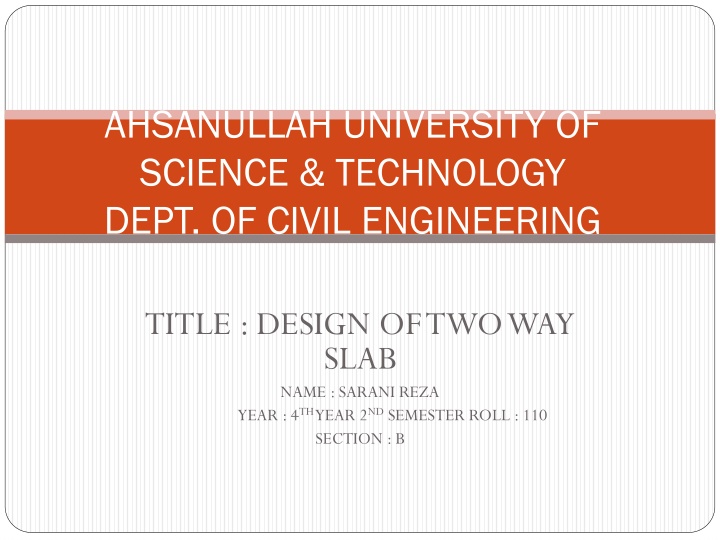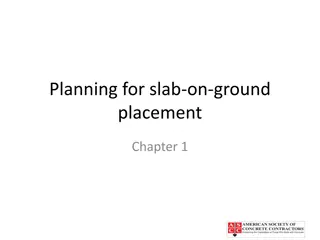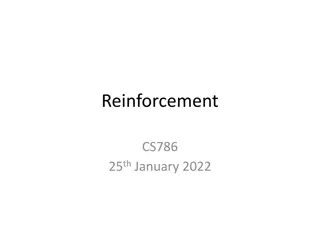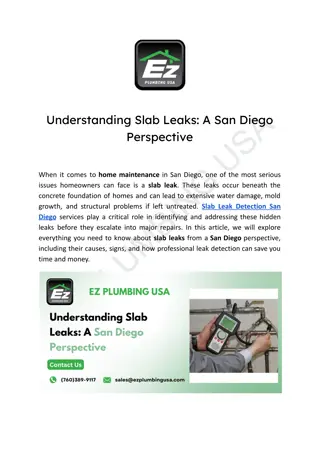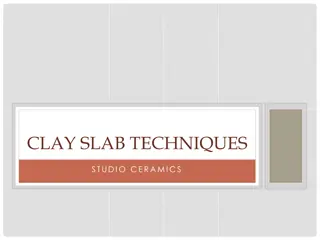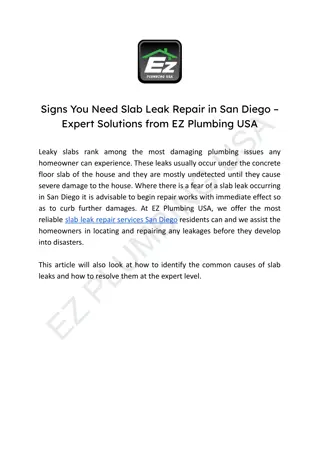Design of Two-Way Slab - Basic Steps and Reinforcement Details
Design of a two-way slab involves choosing layout and type, determining slab thickness, selecting a design method, calculating moments, distributing moments across the slab width, designing reinforcement for beams, and checking shear strengths. The process also includes determining maximum bending moments, slab reinforcement details, and maximum spacing of reinforcement. Two-way slabs can be of different types like flat slab with drop panels, two-way slab with beams, waffle slab, and flat plate. The ratio of long span to short span determines if a slab is considered as spanning in two directions.
Download Presentation

Please find below an Image/Link to download the presentation.
The content on the website is provided AS IS for your information and personal use only. It may not be sold, licensed, or shared on other websites without obtaining consent from the author.If you encounter any issues during the download, it is possible that the publisher has removed the file from their server.
You are allowed to download the files provided on this website for personal or commercial use, subject to the condition that they are used lawfully. All files are the property of their respective owners.
The content on the website is provided AS IS for your information and personal use only. It may not be sold, licensed, or shared on other websites without obtaining consent from the author.
E N D
Presentation Transcript
AHSANULLAH UNIVERSITY OF SCIENCE & TECHNOLOGY DEPT. OF CIVIL ENGINEERING TITLE : DESIGN OF TWO WAY SLAB NAME : SARANI REZA YEAR : 4THYEAR 2NDSEMESTER ROLL : 110 SECTION : B
What is two way Slab? When the ratio of long span to short span is less than 2, then the slab is known as a slab spanning in two directions or two-way slab.
Types of Two-way Slabs: FLAT SLAB WITH DROP PANELS FLAT SLAB WIT DROP PANELS TWO-WAY SLAB WITH BEAMS TWO-WAY SLAB WITH BEAMS
Types of Two-Way Slabs: WAFFLE SLAB WAFFLE SLAB FLAT PLATE FLAT PLATE
BASIC STEPS OF TWO WAY SLAB DESIGN : 1. Choose layout and type of slab. Type of slab is strongly affected by architectural and construction considerations. 2. Choose slab thickness to control deflection. Also, check if thickness is adequate for shear. 3. Choose design method. Equivalent frame method- use elastic frame analysis to compute positive and negative moments. Direct design method - uses coefficients to compute positive and negative slab moments 4. Calculate positive and negative moments in the slab. 5. Determine distribution of moments across the width of the slab. Based on geometry and beam stiffness. 6. Assign a portion of moment to beams, if present. 7. Design reinforcement for moments from steps 5 and 6. Steps 3-7 need to be done for both principal directions. 8. Check shear strengths at the columns.
DETERMINE MEXIMUM BENDING MOMENT :
Ws=WS/3 For Short Span. Wl=wS/3x(3-m2/2) For Long Span. To determine the maximum moment in the supporting beams, we use the uniform load per foot of beam.
Slab Reinforcement of 2 way Slab: Slab Reinforcement of 2 way Slab:
Reinforcement Details Loads After all percentages of the static moments in the column and middle strip are determined, the steel reinforcement can be calculated for negative and positive moments in each strip. Maximum Spacing of Reinforcement At points of max. +/- M: s 2t (ACI 13.3.2) and s 45cm (ACI 7.12.3) Spacing of Reinforcement at critical section shall not exceed two times the slab thickness except for portions of slab area of ribbed Construction.
Min Reinforcement Requirements Min Reinforcement Requirements ( ) = s T&S from ACI 7.12 ACI 13.3.1 A A ( ) ( ) s min Area of reinforcement in each direction for two way slab systems shall be determined from moments at critical sections .But shall not be less than required by shrinkage and temperature reinforcement.
Methods of Design: 1. Direct Design Methods (DDM): Limited to slab systems with uniformly distributed loads and supported on equally spaced columns. Method uses a set of Co- efficents to determine the design moments in critical sections. Two- way slab systems do not meet the limitations of the ACI code 13.6.1 must be analyze causing more accurate procedures. 2. Equivalent Frame Methods( EFM): A three dimensional building is divided in to a series of two dimensional frames by cutting the buildings alone lines midway between columns. The resulting frames are considered separately in the longitudinal and transverse direction of the building and treated floor by floor.
Conclusion: In the case of two-way slab it has been found in practice that a huge moment develops at the support i.e. at the support negative moment is huge. In this case steel must be provided to withstand this moment. In most of the cases extra top bars are provided.
